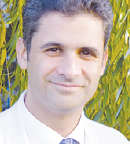In addition to our regular coverage of major news stories from the 2019 ASCO Annual Meeting, here is an additional roundup of important studies related to prostate cancer.
ARAMIS: Darolutamide and Quality of Life
Darolutamide, a next-generation androgen receptor antagonist, significantly prolonged metastasis-free survival vs placebo in men with nonmetastatic castration-resistant prostate cancer, according to the results of the phase III ARAMIS trial: a median of 40.4 months vs 18.4 months, respectively (P < .001).1 Additionally, darolutamide achieved a 29% risk reduction in death compared with placebo.

“Daralutamide significantly improves metastasis-free survival in men with [nonmetastatic castration-resistant prostate cancer].”— Karim Fizazi, MD
Tweet this quote
Enzalutamide and apalutamide have also been reported to improve survival in men with nonmetastatic castration-resistant prostate cancer, but these agents have side effects that can include fatigue, falls, fractures, seizures, and cognitive impairment. Darolutamide may turn out to have an advantage over these other androgen receptor antagonists in terms of adverse events, according to an analysis of the ARAMIS trial showing a more favorable side-effect profile.
“Darolutamide significantly improves metastasis-free survival in men with [nonmetastatic castration-resistant prostate cancer]. Darolutamide is well tolerated, maintains quality of life, and delays worsening of pain and disease-related symptoms when compared with placebo,” stated lead author Karim Fizazi, MD, of the Institut Gustave-Roussy, Villejuif, France. “These findings could make darolutamide an attractive option for men with [nonmetastatic castration-resistant prostate cancer].”
In ARAMIS, the time to pain progression was assessed by the Brief Pain Inventory–Short Form, and quality of life was assessed by the European Organisation for Research and Treatment of Cancer Quality of Life Questionnaire Prostate Cancer module (EORTC QLQ-PR25) and the Functional Assessment of Cancer Therapy–Prostate (FACT-P) subscale for prostate cancer–related symptoms.
Many men with prostate cancer have anxiety about a rising prostate-specific antigen (PSA) level, Dr. Fizazi noted. In an exploratory analysis, darolutamide delayed the time to PSA progression by 87% vs placebo. The median time to PSA progression was 33.2 months for darolutamide vs 7.3 months for placebo (P = .0001).
The time to pain progression was delayed by darolutamide by 35% compared with placebo: the median time to pain progression was 40.3 months vs 25.4 months, respectively (P < .0001). In addition, the time to development of the first symptomatic skeletal event was delayed by 57% with darolutamide (P = .011).
On the FACT-P subscale, quality of life did not deteriorate from baseline in either treatment arm. Time to deterioration on the FACT-P subscale was significantly longer with darolutamide vs placebo (P = .0005). The risk of falls, cognitive impairment, and hypertension was not increased with darolutamide compared with placebo. On the EORTC QLQ-PR25 subscales, darolutamide was superior to placebo for bowel symptoms, sexual activity and functioning, and urinary symptoms.
TOPARP-B: PARP Inhibitors in Castration-Resistant Prostate Cancer
The phase II TOPARP-B randomized trial provides evidence of the benefit of poly (ADP-ribose) polymerase (PARP) inhibition in patients with metastatic castration-resistant prostate cancer whose tumors harbor DNA damage repair genetic alterations.2 The most sensitive tumors to PARP inhibition with olaparib were those with BRCA1 or BRCA2 alterations, but olaparib has activity against other DNA damage repair aberrations as well, according to lead author Joaquin Mateo, MD, PhD, of the Prostate Cancer Translational Research Group, Vall d’Hebron Institute of Oncology, Barcelona, who presented the results.
About 25% of patients with metastatic castration-resistant prostate cancer have DNA damage repair gene aberrations, whether germline or somatic. The most common of these alterations occur in BRCA2.
TOPARP-B was a multistage, adaptive phase II trial designed to identify predictive biomarkers for response to olaparib. Dr. Mateo presented results from the validation set, which were determined prospectively in patients with DNA damage repair aberrations associated with response that were identified in a phase I trial by the same authors.

Joaquin Mateo, MD, PhD
Two different doses of olaparib—400 mg (n = 46) and 300 mg (n = 46) twice daily—were evaluated in a “pick-the-winner” design. All patients were previously treated with docetaxel, and about 90% had also previously received abiraterone. Among all patients, regardless of the specific genetic alteration, the composite response rate was 46% at the lower olaparib dose and 54.3% at the higher dose. (The investigators used a composite of radiologic-, serologic-, and circulating tumor cell–based definitions of response, Dr. Mateo explained.)
The highest composite response rate (83.3%) was found among 30 patients with BRCA1/2-positive prostate cancer. The next highest complete response rate was 57.1% in 7 patients with PALB2-positive disease. ATM-positive patients (n = 19) had a composite response rate of 36.8%. Those with CDK12 alterations (n = 20) had a composite response rate of 25%. This pattern was similar for radiographic progression-free survival.
The most common grade 3 and 4 adverse events were anemia and thrombocytopenia. More dose reductions and treatment discontinuations were reported at the higher dose.
“Gene aberration type matters, and dose may matter, but CDK12 alterations were imbalanced between the two arms,” Dr. Mateo said.
Further studies are needed in this setting. Registration trials for olaparib are ongoing in metastatic castration-resistant prostate cancer, based in part on the results of TOPARP-B.
TAXOMET: No Role for Metformin
Although small studies and anecdotal reports suggest that metformin may have a beneficial effect in patients with prostate cancer, this does not appear to be the case, according to the results of TAXOMET, a randomized phase II trial comparing docetaxel plus metformin vs docetaxel plus placebo in metastatic castration-resistant prostate cancer.3
The TAXOMET investigators randomly assigned 99 patients (both chemotherapy-naive and metformin-naive) with metastatic castration-resistant prostate cancer to receive either docetaxel plus metformin or docetaxel plus placebo, in a 1:1 allocation. The median follow-up was 41.1 months.
For the primary endpoint of PSA response of 50% or more, no statistically significant difference was observed between the two treatment arms: 66% for docetaxel/metformin and 63% for docetaxel alone. Similarly, no significant differences were seen for median progression-free survival (7.4 vs 5.6 months, respectively) and median overall survival (24.6 and 19.7 months).
“This is the first randomized controlled trial to test the combination of metformin and docetaxel in [metastatic castration-resistant prostate cancer]. Metformin did not seem to have clinical benefit in this setting,” said lead author Marc Pujalte Martin, MD, of Centre Antoine Lacassagne, Universite Cote d’Azur in Nice, France. “We look forward to seeing the results of the metformin arm of the STAMPEDE trial, which should be available within a few years.”

“Patients should not take metformin [combined with docetaxel] for prostate cancer. Metformin is not innocuous.”— Mary-Ellen Taplin, MD
Tweet this quote
Formal discussant Mary-Ellen Taplin, MD, of Dana-Farber Cancer Institute, Boston, said, “There was no difference in PSA response in TAXOMET. Many patients ask me about metformin, and so do doctors. Patients should not take metformin “combined with docetaxel chemotherapy for metastatic castration resistant prostate cancer.” Metformin was associated with a high incidence of GU toxicities and is not innocuous.”
Bone-Protecting Agents in Enzalutamide-Treated Patients
Early results of the phase III EORTC 1333/PEACE III trial suggest that bone-protecting agents can virtually eliminate the risk of fractures in men treated with next-generation hormonal agents.4
“Fractures are commonly reported in the investigational arm of phase III studies of new androgen receptor inhibitors, with rates ranging from 4% to 11%. Bone-protecting agents [eg, denosumab, zoledronic acid, alendronate] can reduce the rate of osteoporosis, osteoporotic fractures, and symptomatic skeletal events,” explained lead author Bertrand F. Tombal, MD, PhD, of the Catholic University of Louvain, Belgium.
“The cumulative risk of fracture at 1 year was abolished in both arms [enzalutamide alone vs enzalutamide plus radium-223] of PEACE III with mandatory continuous administration of bone-protecting agents,” Dr. Tombal said. “This study confirms the importance of complying with international recommendations [by using bone-protecting agents] when treating [metastatic castration-resistant prostate cancer], and especially the importance of preventing skeletal complications in patients with bone metastasis.”

Bertrand F. Tombal, MD, PhD
In the phase III ERA 223 trial,5 the combination of abiraterone plus radium-223 led to increased rates of fracture and death compared with abiraterone alone. In that trial, 40% of patients were taking bone-protecting agents after study entry, and post hoc analysis found that this practice significantly reduced the fracture rate from 37% to 15%.
At the ASCO Annual Meeting, Dr. Tombal presented interim results of the PEACE III trial comparing enzalutamide plus radium-223 vs enzalutamide alone. After the results of ERA 223 were published, bone-protecting agents were mandated for both arms of the trial (as of April 2018).
Prior to the safety letter mandating bone-protecting agents in PEACE III, 42.6% of patients were receiving these drugs; after that, 86.7% received them. The median follow-up of patients exposed to bone-protecting agents was 13.3 months; in patients without exposure, median follow-up was 20.0 months.
No fractures were reported at 12 months in either arm among patients treated with bone-protecting agents, whereas the cumulative incidence of fracture in patients who did not take these drugs was 37.4% in the combination therapy arm and 12.4% with enzalutamide alone.

“If I am using radium-223, I will start treatment with a bone-protecting agent, and I will use one any time a skeletal event occurs.”— Michael A. Carducci, MD, FACP
Tweet this quote
“This is an important study. I had been a skeptic about bone-protecting agents, and I didn’t always start my patients on them,” said discussant Michael A. Carducci, MD, FACP, of Sidney Kimmel Comprehensive Cancer Center at Johns Hopkins, Baltimore. “How to use them can be confusing, and there are a lot of questions. The labeling is different for each product, it’s not clear when to use them, and they increase the cost and frequency of visits and monitoring,” he commented.
“Now we know that bone-protecting agents reduce the risk of fracture over time,” Dr. Carducci continued. “With these newer [hormonal] agents, it is likely we will see more fractures over time. This study is practice-changing. If I am using radium-223, I will start treatment with a bone-protecting agent, and I will use one any time a skeletal event occurs. We need more research to define the right duration and schedule for bone-protecting agents. They will reduce the cost associated with skeletal-related events.”
Enzalutamide Plus Abiraterone: No Added Benefit
With expanded treatment options for metastatic castration-resistant prostate cancer, the question arises as to whether adding one newer drug to another will improve outcomes. According to a phase III study, the addition of abiraterone plus prednisone to enzalutamide had no benefit in this setting.6
“Each drug independently improves overall survival in men with mCRPC, and each mitigates the acquired resistance mechanisms of the other drug. We hypothesized that given these features, the combination would prolong drug sensitivity and improve overall survival,” explained lead author Michael J. Morris, MD, of Memorial Sloan Kettering Cancer Center, New York.

Michael J. Morris, MD
“We found that adding abiraterone to enzalutamide does not improve survival. This means there is no change in the current standard of care,” Dr. Morris said. This study is one of three designed to support the use of radiographic progression-free survival as a surrogate endpoint in clinical trials of metastatic castration-resistant prostate cancer, he added.
The study randomly assigned 1,311 patients to either enzalutamide alone or enzalutamide/abiraterone plus prednisone. Treatment arms were well balanced for demographic and disease characteristics. Bone metastases were present in 835 patients.
“The study furnished only enzalutamide, so men assigned to [the other arm] had to secure and purchase their own abiraterone/prednisone,” he explained. There was no significant difference between the two arms for overall survival. At the end of the study, among all patients, 54.2% were alive and 65.7% had disease progression.
The study continued imaging after treatment to determine radiographic progression-free survival. On-treatment radiographic progression-free survival was improved by a modest difference of 4.5 months in the combination therapy arm. The difference between the survival curves narrowed over time. Median radiographic-free progression was 20.7 months in the enzalutamide arm vs 25.2 months in the combination arm.
“A deeper dive into adverse events showed more higher-grade fatigue in the abiraterone/prednisone–containing arm, as well as excess atrial fibrillation and hypertension. These are other reasons not to add abiraterone/prednisone to enzalutamide,” he said.
“There is a correlation between radiographic progression-free survival and overall survival. In a per-patient analysis, the faster the disease progression, the shorter the life,” he noted. “We now have data on more than 4,000 patients in three prospective studies that confirm this association in metastatic castration-resistant prostate cancer,” he said. ■
DISCLOSURE: Dr. Fizazi has received honoraria from Astellas Pharma, Janssen, Merck, and Sanofi; has a consulting or advisory role with Amgen, Astellas Pharma, AstraZeneca, Bayer, Clovis Oncology, CureVac, Essa, Janssen, Orion Pharma GmbH, Roche/Genentech, and Sanofi; and has received reimbursement for travel/accommodations/expenses from Amgen and Janssen. Dr. Mateo has had a consulting or advisory role with Amgen, AstraZeneca, Janssen, and Roche; is a member of the speakers bureau for Astellas Pharma, AstraZeneca, and Sanofi; and has received reimbursement for travel/accommodations/expenses from AstraZeneca, BeiGene, Ipsen, and Sanofi. Dr. Martin reported no conflicts of interest. Dr. Taplin has received honoraria from Janssen Pharmaceuticals, Clovis Oncology, Astellas Pharma, Incyte, UpToDate, Research to Practice, Pfizer, and Bayer AG; has been a consultant/advisor for Janssen Pharmaceuticals, Bayer AG, Guidepoint Global, Best Doctors, UpToDate, Clovis Oncology, Research to Practice, Myovant Sciences, Incyte, Pfizer, and AstraZeneca; has received institutional research funding from Janssen Pharmaceuticals, Medivation, Bayer AG, Tokai Pharmaceuticals, and Pfizer; and has received reimbursement for travel/accommodations/expenses from Medivation, Janssen Pharmaceuticals, Tokai Pharmaceuticals, Astellas Pharma, Incyte, Pfizer, Clovis Oncology, and Bayer AG. Dr. Tombal has received honoraria from Amgen, Astellas Pharma, Bayer, Ferring, Janssen, Pfizer, and Sanofi; has been a consultant/advisor for Astellas Pharma, Bayer, Ferring, Janssen, Sanofi, Steba Biotech, and Takeda; is a member of the speakers bureau for Amgen and Janssen; has received institutional research funding from Ferring; and has received reimbursement for travel/accommodations/expenses from Amgen, Astellas Pharma, Bayer, Ferring, Janssen, and Sanofi. Dr. Carducci has been a consultant/advisor for Pfizer, Roche/Genentech, Foundation Medicine, and AbbVie and has received research funding from EMD Serono, Pfizer, and Effector. Dr. Morris has been a consultant/advisor for Advanced Accelerator Applications, Astellas Pharma, Bayer, Blue Earth Diagnostics, Endocyte, Tokai Pharmaceuticals, Oric, and Tolmar Pharmaceuticals; has received institutional research funding from Bayer, Corcept Therapeutics, Endocyte, Progenics, Roche/Genentech, and Sanofi; and has received reimbursement for travel/accommodations/expenses from Bayer and Endocyte.
REFERENCES
1. Fizazi K, Shore ND, Tammela T, et al: Impact of darolutamide on pain and quality of life in patients with nonmetastatic prostate cancer. 2019 ASCO Annual Meeting. Abstract 5000. Presented May 31, 2019.
2. Mateo J, Porta N, McGovern UB, et al: TOPARP-B: A phase II randomized trial of the poly(ADP)-ribose polymerase (PARP) inhibitor olaparib for metastatic castration resistant prostate cancer (mCRPC) with DNA damage repair alterations. 2019 ASCO Annual Meeting. Abstract 5005. Presented May 31, 2019.
3. Martin MP, Borchiellini D, Viotti J, et al: TAXOMET: A French prospective multicenter randomized controlled phase II study comparing docetaxel plus metformin vs docetaxel plus placebo in mCRPC. 2019 ASCO Annual Meeting. Abstract 5004. Presented May 31, 2019.
4. Tombal BF, Loriot Y, Saad F, et al: Decreased fracture rate by mandating bone-protecting agents in the EORTC 1333/PEACE III trial comparing enzalutamide and Ra223 versus enzalutamide alone: An interim safety analysis. 2019 ASCO Annual Meeting. Abstract 5007. Presented May 31, 2019.
5. Smith M, Parker C, Saad F, et al: Addition of radium-223 to abiraterone acetate and prednisone in patients with castration-resistant prostate cancer and bone metastases (ERA 223): A randomized, double-blind, placebo-controlled, phase 3 trial. Lancet Oncol 20:408-419, 2019.
6. Morris MJ, Heller G, Bryce AH, et al: Alliance A031201: A phase III trial of enzalutamide vs enzalutamide, abiraterone, and prednisone for metastatic castration resistant prostate cancer. 2019 ASCO Annual Meeting. Abstract 5008. Presented May 31, 2019.

